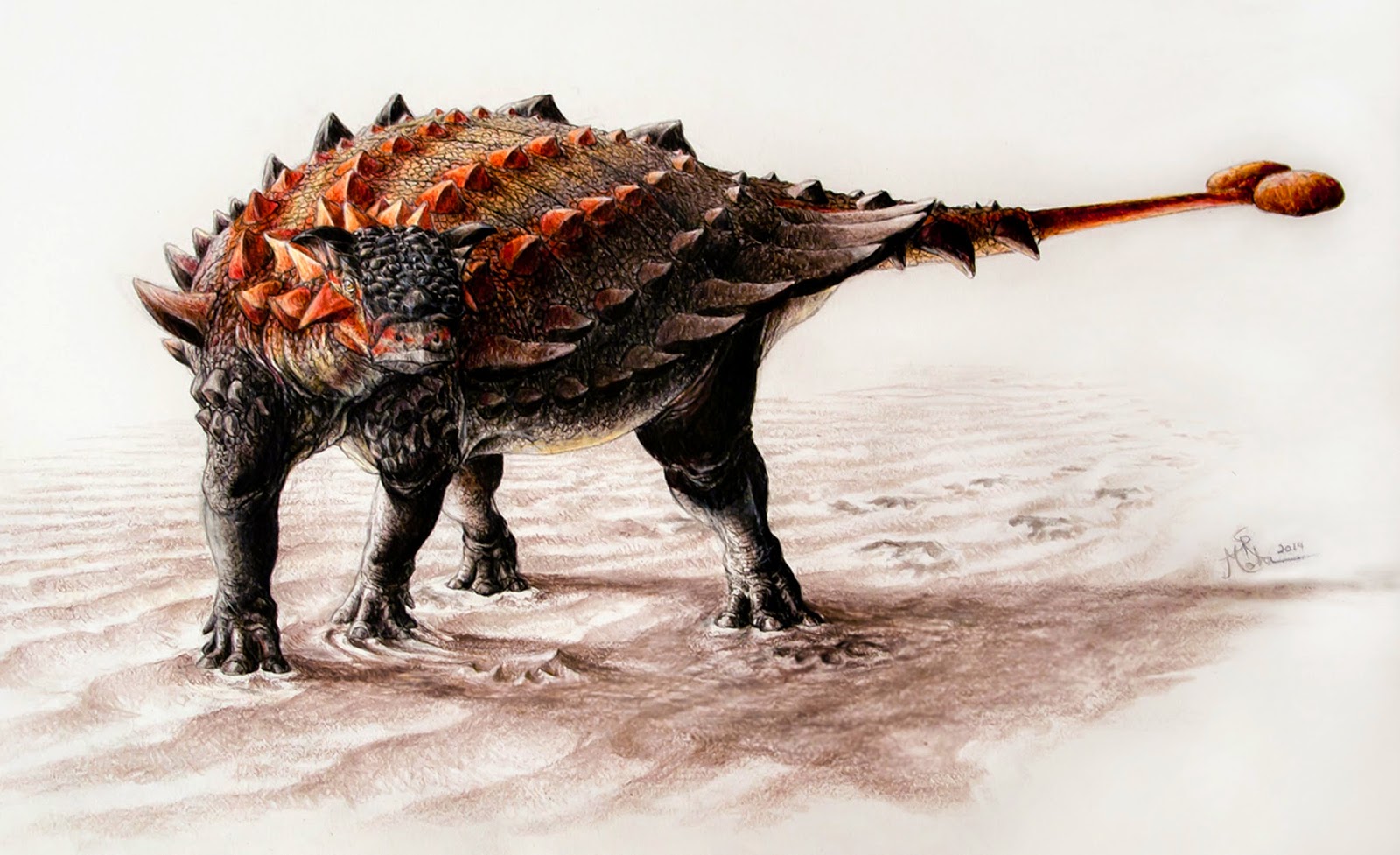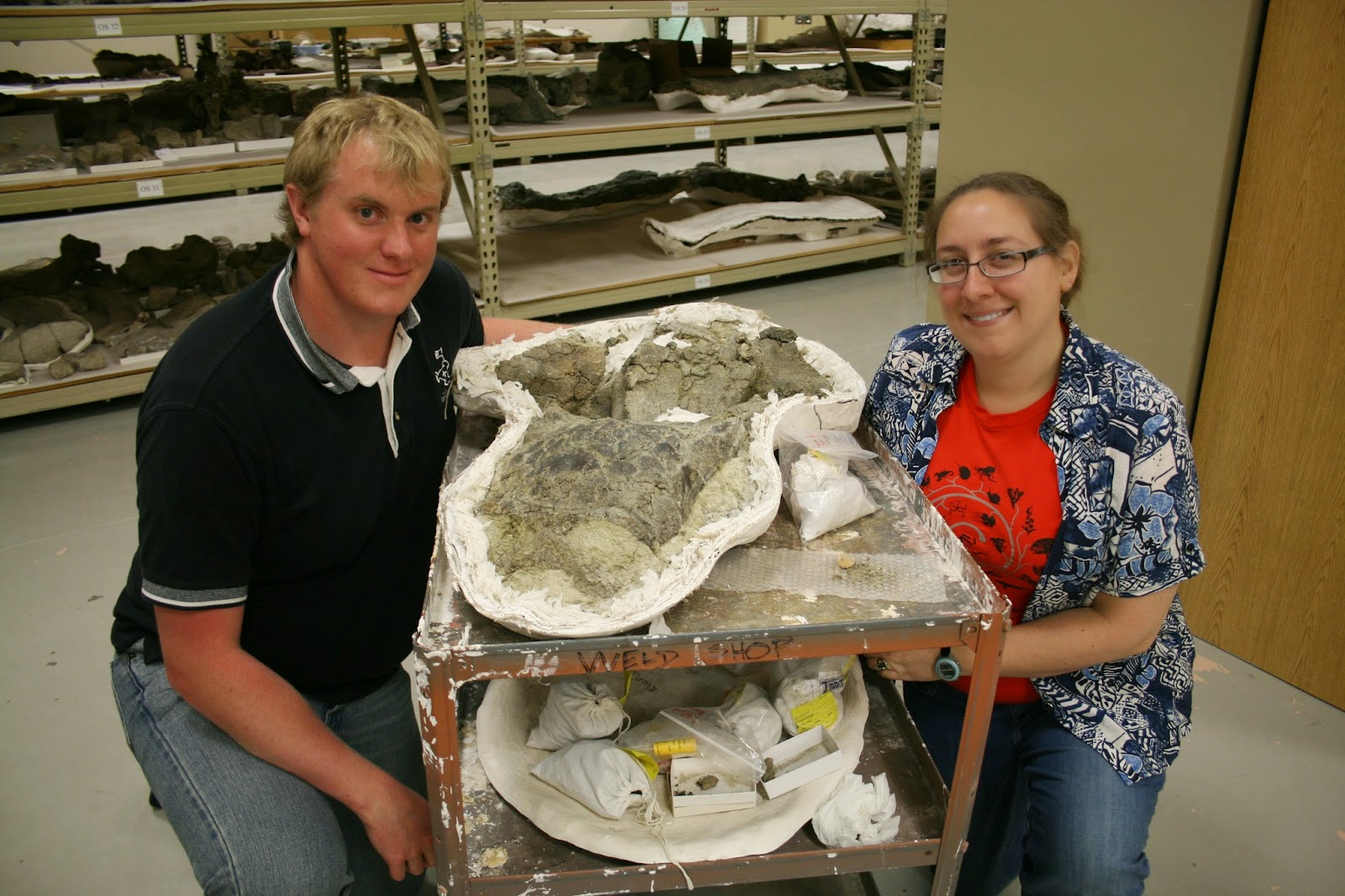It was a whirlwind year for dinosaur palaeontology, yet
again. This week I'm writing about what I consider the most important news in
my science field for 2014, for the Science Borealis blog carnival. There are so
many great stories to choose from! Kulindadromeus and feather-like structures in ornithischians? The bizarro new reconstruction of a short-legged Spinosaurus? Both of those stories were pretty interesting, but my choice has
to be the description of multiple skeletons of the Mongolian ornithomimosaur
Deinocheirus.
If you like dinosaurs, there's a good chance you've heard
about Deinocheirus before, even if it's not quite a household name like
Stegosaurus or Triceratops. Deinocheirus (which means "Terrible Hands") was found during the Polish-Mongolian
expeditions in the 1960s, and up until very recently has only been known by
this single specimen, a pair of tremendous arms. And I do mean tremendous!
Me, in 2007, mimicking the 'zombie arms' of Deinocheirus, rather convincingly if I do say so myself.
A few years ago, the quarry for this holotype specimen was
relocated and some gastralia (belly ribs) were found and described, but besides that this
has been it. What on earth did the rest of this dinosaur look like? Was it a
carnivore, herbivore, or something else? Where did it fit in the Cretaceous
Gobi ecosystem?
While the exact evolutionary relationships of Deinocheirus have
been enigmatic, there's been a general consensus that it was some kind of
ornithomimosaur, or ostrich-mimic dinosaur. Even if you're not a dino-buff,
you'll recognize ornithomimids as the stampeding dinosaurs in Jurassic Park –
Gallimimus was the one 'flocking this way', and, conveniently, Gallimimus is a
commonly encountered fossil in the Upper Cretaceous rocks of the Gobi Desert
and would have lived alongside Deinocheirus. Where Gallimimus is an elegant,
sprightly kind of dinosaur, Deinocheirus, it turns out, is not at all, not even
a little bit.
It turns out that Deinocheirus is even more surprising than we would have ever guessed; the giant arms are nothing compared to the
weirdness of the rest of its skeleton. Deinocheirus looks like a cross between
a therizinosaur and a hadrosaur. It's a big, broad-bellied ornithomimosaur with
a 'sail' of heightened neural spines on its vertebrae, and a widened,
shovel-like snout with a deep jaw and tiny eyes. It looks like it was adapted
for eating vegetation and had gastroliths preserved in its stomach region, but
also had fish scales in there as well, prompting the authors to describe it as
a megaomnivore, which is among my new favourite words of the year. Given that its close relatives the ornithomimids are known to have had feathers, as well as many other theropod dinosaurs, it is most likely that Deinocheirus had at least some feathers.
Deinocheirus, by the always-incredible Michael Skrepnick.
I will forever be jealous of my colleague Derek Larson, who
was on the 2009 Korea-Mongolia International Dinosaur Project expedition that found the new
skeletons of Deinocheirus (I was there just a year later, and it was a great
year...but no Deinocheirus). I'm so thrilled that I've been able to see the
original bones in person, and they really are quite something to see – I hope
that the specimen will eventually be mounted and put on display so everyone can
see it for themselves, too!
The "Canadian contingent" (which actually includes at least one American and one Australian, but let's not be too picky) at the 2013 Hwaseong International Dinosaurs Expedition Symposium last December, gawking away at Deinocheirus.
Deinocheirus is also an important reminder that Mongolian fossils are under threat. Sadly, many probably excellent skeletons are removed
illegally from Mongolia every year – no fossils are allowed to leave the
country without a permit, and none can be sold, so any fossils from
"Central Asia" on the auction blocks are almost certainly stolen
goods. The Deinocheirus skull had made its way out of Mongolia some years ago,
and was, thankfully, repatriated to Mongolia when word of the new skeletons
began to circulate throughout the palaeontological community. Incredibly, the
skull actually belonged to one of the newly collected skeletons! This is a
story that could have ended very differently – we might not have known about
the strange skull of Deinocheirus because of fossil poaching.
Poached fossils make everybody sad! Here Phil Currie is showing the remains of a tyrannosaur skull that was improperly collected by poachers and destroyed in the process.
So why choose Deinocheirus over Kulindadromeus or
Spinosaurus? Like I said, all three are top contenders for the most surprising
finds of 2014. In some ways, the fuzz of Kulindadromeus is less surprising, and
its significance lies in the fact that it lends support to the hypothesis that
fuzz was present in most dinosaurian clades. Spinosaurus has also long been
considered a specialist in aquatic foods, so while the new skeletal revision is
certainly weird, it's not quite a fundamental re-envisioning of this beast. But
Deinocheirus is way beyond what anyone would have ever predicted the rest of
the skeleton would have looked like, and just goes to show that there are
surprises waiting around every corner for us when it comes to dinosaur
diversity. And, in my opinion, Deinocheirus leads to even more questions than it answered: what was it doing with that sail; why is its jaw so deep and its eyes so small; what kind of environment produces a megaomnivore like that; are any of the bits and pieces of what we thought was Gallimimus actually parts of juvenile Deinocheirus? I could go on and on.
Congratulations to my colleagues in Korea and Mongolia for
organizing the Korea-Mongolia International Dinosaur Project expeditions – I'm
sure this is just the first of many wonderful projects that will result from
those years of fieldwork.

















































